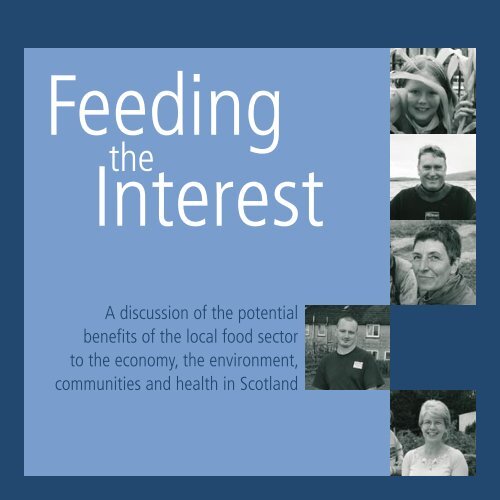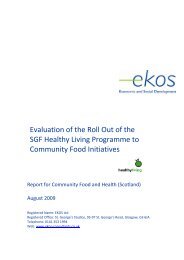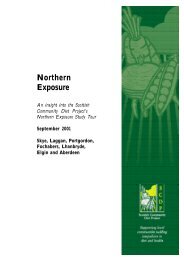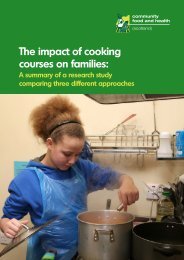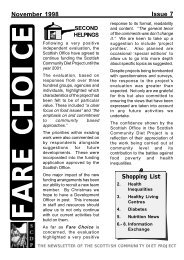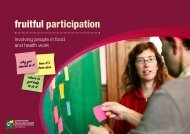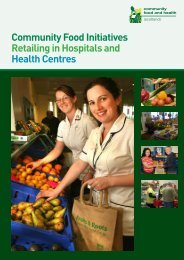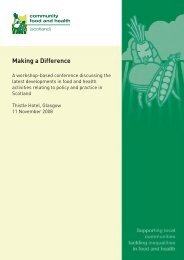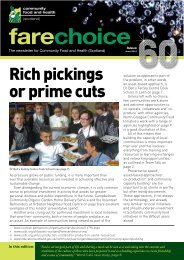Feeding the Interest - Community Food and Health
Feeding the Interest - Community Food and Health
Feeding the Interest - Community Food and Health
- No tags were found...
You also want an ePaper? Increase the reach of your titles
YUMPU automatically turns print PDFs into web optimized ePapers that Google loves.
<strong>Feeding</strong><strong>the</strong><strong>Interest</strong>A discussion of <strong>the</strong> potentialbenefits of <strong>the</strong> local food sectorto <strong>the</strong> economy, <strong>the</strong> environment,communities <strong>and</strong> health in Scotl<strong>and</strong>
<strong>Feeding</strong><strong>the</strong><strong>Interest</strong>introduction 2summary 4local food 6economy 9environment 12A discussion of <strong>the</strong> potentialbenefits of <strong>the</strong> local food sectorto <strong>the</strong> economy, <strong>the</strong> environment,communities <strong>and</strong> health in Scotl<strong>and</strong>communities 14health 16policy 18fur<strong>the</strong>rinformation 21
introduction<strong>Food</strong> occupies a fundamental position in people’s lives. Regardlessof age, income, social st<strong>and</strong>ing, culture or religious belief, everyindividual has to eat <strong>and</strong> so has a stake in where <strong>the</strong>ir food comesfrom <strong>and</strong> how it is produced. But food adds much more to life – it ispart of our heritage <strong>and</strong> shared meals are an important way to shareour culture with family <strong>and</strong> friends.<strong>Food</strong> <strong>the</strong>refore connects to many policy areas including <strong>the</strong> economy,heath, social justice, sustainability, agriculture <strong>and</strong> rural development.During <strong>the</strong> 1990s, a ‘local food sector’ emerged in <strong>the</strong> UK with adiverse range of organisations <strong>and</strong> businesses working to promotesocially <strong>and</strong> environmentally sustainable food systems.The importance of <strong>the</strong> sector is reflected in <strong>the</strong> Scottish ExecutivePartnership Agreement (2003) A Partnership for a Better Scotl<strong>and</strong> i :• We will encourage localised food distribution systems involvingmore local processing of produce.• We will support local marketing schemes, with clear accreditation<strong>and</strong> labelling of local produce… <strong>and</strong> food produced by organic <strong>and</strong>sustainable farming methods.• We will support regional marketing co-operatives where this isnecessary to enhance <strong>the</strong> marketing strength of food producers.The following discussion paper considers <strong>the</strong> benefits of local food;identifies opportunities for development; highlights barriers <strong>and</strong>encourages action. It also asks important questions which are <strong>the</strong> basisfor future discussion <strong>and</strong> action.2iwww.scotl<strong>and</strong>.gov.uk/library5/government/pfbs-02.asp
Sampling local cheesesat a farmers market inPortree3
summaryLocal food in Scotl<strong>and</strong> impacts on four main policy areas: <strong>the</strong> economy,<strong>the</strong> environment, communities <strong>and</strong> health.This discussion paper looks at each of <strong>the</strong>se areas in turn, <strong>and</strong>highlights important questions for discussion.In recent years, food <strong>and</strong> farming crises such as BSE <strong>and</strong> foot <strong>and</strong>mouth disease have raised concerns about <strong>the</strong> food we eat: where itcomes from, how it is produced <strong>and</strong> how it affects us <strong>and</strong> <strong>the</strong> worldaround us. Increasing consumer enthusiasm for farmers markets <strong>and</strong>organic food are examples of a growing awareness of <strong>the</strong> importanceof quality <strong>and</strong> choice as well as cost.Over <strong>the</strong> past decade, <strong>the</strong> idea of a ‘local food sector’ has gainedmomentum <strong>and</strong> credibility. The case study examples in this paperhighlight only some of <strong>the</strong> local food initiatives which have developedin Scotl<strong>and</strong>.There is clearly scope for developing <strong>the</strong> sector because of <strong>the</strong> wideranging<strong>and</strong> long-term benefits it can bring. These may include fresher<strong>and</strong> better quality food for consumers, less pollution, more moneycirculating in local economies, increased employment, opportunities todevelop new skills, as well as <strong>the</strong> potential to add value <strong>and</strong> open upnew markets.Local food has moved up <strong>the</strong> policy agenda <strong>and</strong> <strong>the</strong> links betweenlocal food <strong>and</strong> sustainable development are increasingly recognised.However, <strong>the</strong>re are some obstacles to developing <strong>the</strong> sector, many ofwhich are economic <strong>and</strong> stem from a lack of local infrastructure. Also,because local food has an impact on four very diverse fields, <strong>the</strong>re is nointegrated policy to shape its development. Such policy would not onlyrecognise <strong>the</strong> importance of <strong>the</strong> local food sector but would also act asan instrument for overcoming some of <strong>the</strong>se obstacles.4
case studyForthValley<strong>Food</strong>LinksCraigend Farmnear Stirlingreceived agrant fromForth Valley<strong>Food</strong> Linksenabling it todiversify intosoft fruits.The farm'sraspberrypreserves aresold locally.Through aseries of sixworkshops,whichbroughttoge<strong>the</strong>rindividualsin centralScotl<strong>and</strong> who had aninterest in food issues, <strong>the</strong>Forth Valley <strong>Food</strong> Futuresprocess highlighted a lackof diversity in local foodproduction,barriersto access what local produce <strong>the</strong>re was, <strong>and</strong> a needfor comprehensive advice <strong>and</strong> information on ways toovercome <strong>the</strong>se difficulties. Local people identified <strong>the</strong>need for a new food organisation in <strong>the</strong> area which wouldaddress <strong>the</strong>se shortcomings <strong>and</strong>, with funding from <strong>the</strong>Scottish Executive, Forth Valley NHS Board<strong>and</strong> Clackmannanshire, Falkirk <strong>and</strong> Stirling Councils, ForthValley <strong>Food</strong> Links was born in 2002. With an office base inStirling, three <strong>Food</strong> Links Officers are now working activelywith commercial farmers, retailers, <strong>and</strong> community groupsacross <strong>the</strong> three council areas to increase <strong>the</strong> production,availability <strong>and</strong> consumption of local food for local people.7
The experience of local initiatives suggests <strong>the</strong>re is potential to developa strong <strong>and</strong> well-supported local food sector in Scotl<strong>and</strong>. However,taking action on local food involves more than local activity. It is apolitical issue which is influenced by local, national <strong>and</strong> internationaldevelopments. It is shaped globally through <strong>the</strong> World TradeOrganisation <strong>and</strong> within Europe by <strong>the</strong> Common Agricultural Policy.In Scotl<strong>and</strong>, <strong>the</strong> policy agenda is clearly changing as a result of <strong>the</strong>Forward Strategy for Scottish Agriculture iii which recognises <strong>the</strong> needto shorten <strong>the</strong> food supply chain.Discussion of local food issues is, <strong>the</strong>refore, timely.local foodkey questionsShould definitions of ‘localfood’ be for specific purposes,such as trading st<strong>and</strong>ards,farmers markets or supermarketlabelling?How can our food culturechange towards one whichvalues seasonality, localdistinctiveness <strong>and</strong> lessprocessed foods?Are consumers sufficientlyinformed about <strong>the</strong> health,quality, source <strong>and</strong> productionmethods of food so <strong>the</strong>y canmake better informed choicesabout <strong>the</strong> food <strong>the</strong>y eat?How can motivated <strong>and</strong>dedicated individuals besupported in <strong>the</strong>ir involvementin local food initiatives?8iiiiiLocal <strong>Food</strong> Routes: A summary report of <strong>Food</strong> Futures (2001) The Soil Association, Bristolwww.scotl<strong>and</strong>.gov.uk/library3/agri/fssa-00.asp
economyAlthough it is difficult to measure <strong>the</strong> economic impact of <strong>the</strong> localfood sector on <strong>the</strong> economy, as many initiatives are small scale <strong>and</strong>geographically scattered, experience indicates that <strong>the</strong>re are benefits.The food industry – production, processing, manufacture, distribution<strong>and</strong> retailing – is important to <strong>the</strong> economy. Much of this activity is inrural areas <strong>and</strong> so is of special importance to <strong>the</strong> rural economy.Tourism is an important market for local foods with many farmsdiversifying <strong>and</strong> producing local food for <strong>the</strong> tourist trade. Connectingspeciality food to tourism <strong>and</strong> <strong>the</strong> quality restaurant sector, as in Skye& Lochalsh, is likely to benefit local economies.<strong>Food</strong> produced <strong>and</strong> sold locally usually reaches <strong>the</strong> final consumerthrough shorter marketing chains. When sold direct by <strong>the</strong> producer<strong>the</strong>re is greater scope for a larger proportion of <strong>the</strong> consumer’s poundto stay in <strong>the</strong> area ra<strong>the</strong>r than going to a producer or processorelsewhere iv .While adding value through local skilled processing, farmdiversification or using existing local markets for direct sales keepsmoney circulating for longer in local economies. Significant amounts ofproduce may be sold locally through farm gate sales, home deliveriesor farm shops. Economic potential may also lie in <strong>the</strong> integrity of <strong>the</strong>produce itself – responsibly produced, community-supported <strong>and</strong>health-sustaining food.By using <strong>the</strong>se local approaches, farms <strong>and</strong> o<strong>the</strong>r food producers maybe more viable <strong>and</strong> less likely to be affected by external forces such asdisease or currency fluctuation. This is also important for <strong>the</strong> survival<strong>and</strong> development of smaller-sized farms.However, <strong>the</strong>re are also economic barriers to supplying local food.These may include:9
• Limited resources for promoting products – a serious issue for small<strong>and</strong> micro-businesses• Gaps in local processing which, if rectified, could shorten supplychains <strong>and</strong> provide local outlets <strong>and</strong> jobs• Lack of infrastructure can lead to insufficient volume of activityto sustain growth without subsidy, for example small throughputabattoirs• Poor local food distribution networks <strong>and</strong> carriers favouring bulkdeliveries• Supply may not fit with dem<strong>and</strong>, limiting access to markets for bothproducers <strong>and</strong> consumers.There can also be problems with range, quantity, seasonality <strong>and</strong>regularity of supply. However, <strong>the</strong> Skye & Lochalsh <strong>Food</strong> <strong>and</strong> DrinkInitiative, particularly its <strong>Food</strong> Link Van, is a good example of balancingsupply <strong>and</strong> dem<strong>and</strong>, for <strong>the</strong> benefit of both consumers <strong>and</strong> producers.To date, advice <strong>and</strong> support to food companies has focused on <strong>the</strong>export market <strong>and</strong> adding value, reflecting <strong>the</strong> interests of <strong>the</strong> big,ra<strong>the</strong>r than <strong>the</strong> small players, who are more likely to be able to supply<strong>the</strong> local market. There is a dual challenge for <strong>the</strong> local food sector:to keep as much as possible of <strong>the</strong> food chain local whilst developingmarkets <strong>and</strong> exporting capacity.Developing local food initiatives means engaging local enthusiasm<strong>and</strong> expertise as well as appealing to business self-interest. Dynamic,energetic individuals, sometimes volunteers, who are committed to<strong>the</strong> issues, drive many successful initiatives in <strong>the</strong> local food sector.However, commitment from business <strong>and</strong> consumers is also needed toallow <strong>the</strong> local market to develop v . Business advice is important too.At a UK level, <strong>the</strong> Institute of Grocery Distributors (IGD) vi publishes bestpractice guides on local sourcing <strong>and</strong> for small businesses supplyingsupermarkets. Business advice of this kind could be developed for <strong>the</strong>local food sector.economykey questionsHow are <strong>the</strong> infrastructure needsof local food processing <strong>and</strong>production best tackled?How can best practice beshared, businesses advised <strong>and</strong>cross-sectoral local initiativesdeveloped?Should partnerships betweenlarge-scale retailers <strong>and</strong> <strong>the</strong> localfood sector be encouraged?How can major public sectorpurchasers, such as healthboards <strong>and</strong> local authorities,be encouraged to use morelocal produce in <strong>the</strong>ir cateringdepartments?10ivvviwww.plugging<strong>the</strong>leaks.org<strong>Food</strong> projects <strong>and</strong> how <strong>the</strong>y work: Pauline McGlone, Barbara Dobson, Elizabeth Dowler <strong>and</strong> Michael Nelson,Joseph Rowntree Foundation, 1999www.igd.com
environmentThe benefits of local food systems extend far beyond <strong>the</strong> marketplace.Fewer road miles, less packaging, environmentally friendly farmingsystems, stronger local economies <strong>and</strong> <strong>the</strong> preservation of regionalspecialities are all potential benefits that make for a healthierenvironment <strong>and</strong> population.Consumers are increasingly concerned about how food is produced,including chemical use, rearing practice, animal welfare, biodiversity,quality, traceability, origin <strong>and</strong> <strong>the</strong> impact on <strong>the</strong>ir health. Localmarkets, farmers markets <strong>and</strong> direct sales provide an opportunity for<strong>the</strong>se concerns to be listened to <strong>and</strong> acted on.The Countryside Agency’s Eat <strong>the</strong> View initiative in Engl<strong>and</strong> vii encourageslinks between environmentally-sound production <strong>and</strong> local food. Thisincludes showing consumers that <strong>the</strong>y can support <strong>the</strong> local countrysideby choosing local products produced using sustainable methods.environmentkey questionsHow can local food systemscontribute to sustainabledevelopment?What would enable consumersto support local foods producedin an environmentally friendlyway?The cost of conventionally produced food rarely reflects <strong>the</strong> externalfactors associated with producing it, for example acid rain or globalwarming resulting from pollution from transport. There are manyenvironmental <strong>and</strong> consumer concerns linked to conventionallyproduced food. These include <strong>the</strong> use of irradiation, food additives<strong>and</strong> antibiotics; genetic engineering; or high levels of pesticides <strong>and</strong>chemical inputs. The local food sector generally aims to reject all of<strong>the</strong>se. There is an increasing association between tourism, food <strong>and</strong><strong>the</strong> environment. For example, a study commissioned by <strong>the</strong> Sou<strong>the</strong>rnUpl<strong>and</strong>s Partnership to investigate <strong>the</strong> potential for developing a ‘greenlabel’ for <strong>the</strong> area concluded that linking sustainable production with localbr<strong>and</strong>ing could provide opportunities to add value <strong>and</strong> make productsmore marketable viii .There is a need for more research into <strong>the</strong> environmental impact offood production, as well as clear policies to link biodiversity, pollution,food miles <strong>and</strong> wider sustainability issues. It is also important to sharegood practice from initiatives already developed.12vii www.eat-<strong>the</strong>-view.org.ukviii Review of Potential for Green Labelling in <strong>the</strong> Sou<strong>the</strong>rn Upl<strong>and</strong>s, RSK ERA Ltd for <strong>the</strong> Sou<strong>the</strong>rn Upl<strong>and</strong>s Partnership, 10 2002
EarthShareEarthShare, near Forres, is a not-for-profitcommunity-supported agriculture schemeestablished in 1994, in which <strong>the</strong> subscribersshare <strong>the</strong> risks <strong>and</strong> benefits involved in <strong>the</strong>growing of <strong>the</strong>ir food using organic methods.The organisation grows over 50 varieties ofsoft fruit <strong>and</strong> vegetables for distribution tosome 200 families. Subscribers sign up to <strong>the</strong>scheme for a year <strong>and</strong> in return, <strong>the</strong>y receive<strong>the</strong>ir share of <strong>the</strong> year’s harvest in <strong>the</strong> formof a weekly box. There is a discount for anysubscriberswho help with labour-intensive work suchas weeding <strong>and</strong> soft fruit picking.case study<strong>Health</strong>y food is produced locally at costprice with no intermediary <strong>and</strong> minimaladvertising <strong>and</strong> distributioncosts. The weekly boxesare taken to pick-up points in Findhorn, Forres or Elgin.Subscribers collect <strong>the</strong>ir own boxes <strong>and</strong> are encouraged toorganise a rota to collect for <strong>the</strong>ir nearest neighbours. Thescheme promotes recycling <strong>and</strong> general environmentalawareness, organises regular social events <strong>and</strong> keepssubscribers up to date through notes in <strong>the</strong>weekly box <strong>and</strong> a newsletter, The OnionString. Subscribers say <strong>the</strong>y benefit bothfrom <strong>the</strong> fresh local produce <strong>and</strong> <strong>the</strong>opportunity to work on <strong>the</strong> l<strong>and</strong> in harmonywith nature <strong>and</strong> <strong>the</strong> changing seasons.13
communities<strong>Food</strong> is important to society in many ways. This is clearly demonstratedby <strong>the</strong> many community projects <strong>and</strong> initiatives which are tacklinglocally identified issues. However, <strong>the</strong>re is a lack of policy which linkslocal food to social need. The local food sector has <strong>the</strong> potential toalleviate social <strong>and</strong> economic disadvantage <strong>and</strong> <strong>the</strong> impact this hason business, diet <strong>and</strong> health. There is significant scope to increase <strong>the</strong>uptake of local food. With a co-ordinated approach, locally producedfoods could be sold locally at affordable prices <strong>and</strong> still be profitablefor <strong>the</strong> supplier. This would need greater co-operation amongproducers <strong>and</strong> better connections between suppliers <strong>and</strong> consumers.Co-operative working associated with local food initiatives – suchas developing project management skills, networking <strong>and</strong> buildinglinks with local colleges <strong>and</strong> <strong>the</strong> tourism sector – can make a valuablecontribution to community development <strong>and</strong> social capital building.communitieskey questionsWhich organisations are bestplaced to nurture <strong>and</strong> promote<strong>the</strong> local food sector atcommunity level?How can access to existing localproduce be improved to benefitconsumers?An issue for remote rural communities is getting fresh local producera<strong>the</strong>r than centrally sourced food, which is often all that is available.Even in more urban areas, people may depend on a small corner shopwith little fresh local produce. One way to exp<strong>and</strong> <strong>the</strong> market is toconvince local businesses that it makes good business sense to stocklocal, traceable produce.Home food production is important for some, although allotmentsare relatively scarce in Scotl<strong>and</strong> compared to Engl<strong>and</strong>. Gardenproduction of fruit <strong>and</strong> vegetables is geographically widespread, <strong>and</strong>is a significant source for some households. Traditional social pastimes,such as wild fruit harvesting, have declined in recent years, but o<strong>the</strong>rs,such as ga<strong>the</strong>ring fungi, have increased.Recent crises in food <strong>and</strong> farming have dented consumer confidence.Encouraging consumers to have direct contact with producers is oneway to improve consumer confidence. Farmers markets, vegetable boxschemes, community-supported agriculture <strong>and</strong> o<strong>the</strong>r forms of directsales, are good examples of this.14
Knowetop<strong>Community</strong>FarmKnowetop <strong>Community</strong>Farm was set up in 1980 inWest Dumbarton to providerecreational, educational,<strong>and</strong> employmentopportunities for peopleliving in a deprived area.The farm has sincebecome a limitedcompany; has grownfrom three huts toaround twelve acres; is aregistered SQA trainingcentre for horticulture <strong>and</strong> animal care;<strong>and</strong> a New Deal provider.case studySchools make good use of <strong>the</strong> farm <strong>and</strong>its new educational unit. The vegetablegarden sells producedirectly to local residents<strong>and</strong> visitors.Recent additions include anew shop, training room <strong>and</strong>indoor soft play area.15
healthThe local food sector can have positive benefits on health. <strong>Food</strong> can befresher because it is nearer to its market <strong>and</strong> is likely to be less processed<strong>and</strong> <strong>the</strong>refore contain fewer additives.There are also health benefits from increased physical activity (such asgardening or collecting wild food), increased social interaction (throughinvolvement in <strong>the</strong> community), more self-worth <strong>and</strong> control, <strong>and</strong> <strong>the</strong>chance to share experiences with o<strong>the</strong>rs.Access to <strong>and</strong> availability of fruit <strong>and</strong> vegetables have been recognisedfor some time as key components of national <strong>and</strong> local health strategies.<strong>Community</strong> cafés <strong>and</strong> food co-operatives, often supported as part ofhealth strategies, are increasingly aware of <strong>the</strong> benefits of using localproduce so that people can eat fresh local food. People are more likely tosupport initiatives when <strong>the</strong>y see a direct link with local producers.healthkey questionsHow can local <strong>and</strong> nationalhealth strategies be connectedto locally sourced food?What are <strong>the</strong> best methodsof addressing <strong>the</strong> barriers ofaffordability, availability, culture<strong>and</strong> skills relating to accessinglocal food?People need to know more about food, nutrition <strong>and</strong> health. Youngpeople may need to learn about raw ingredients as well as basic cookingskills. This means a fundamental change in attitude which sees eatingwell as better, <strong>and</strong> not just healthier.The new <strong>Health</strong> Improvement (HI) directorate within <strong>the</strong> <strong>Health</strong>Department of <strong>the</strong> Scottish Executive indicates that policy makersregard health improvement as a major new crosscutting priority. Eachdepartment within <strong>the</strong> Scottish Executive now has to review how itinteracts with <strong>and</strong> can contribute to improving <strong>the</strong> health of <strong>the</strong> peopleof Scotl<strong>and</strong>. The HI framework will fit across multi-agency departmentalbusiness plans <strong>and</strong> this will mean a more integrated approach toaddressing food <strong>and</strong> local food.The connections between local food systems, social exclusion <strong>and</strong> healthhave not been quantified. Although <strong>the</strong> relationship between health <strong>and</strong>dietary behaviour is well known, <strong>the</strong> extent to which dietary problemscan be addressed by local food (ra<strong>the</strong>r than changes in dietary <strong>and</strong>o<strong>the</strong>r behaviour such as exercise) is less clear. This is an area which needsfur<strong>the</strong>r research.16
case studyRenfrewshire <strong>Community</strong> GardensRenfrewshire <strong>Community</strong> Gardens involves nursery <strong>and</strong>school age children <strong>and</strong> disabled <strong>and</strong> elderly peopleactive on 11 different sites. As part of <strong>the</strong> initiative, pupils atMoorpark Primary School in Renfrew have created <strong>the</strong>irown vegetable garden. Thechildren have learned about planting,composting, recycling, <strong>and</strong> much more.They also harvest, prepare <strong>and</strong> cook <strong>the</strong>irproduce in <strong>the</strong> classroom so <strong>the</strong>y cantaste what <strong>the</strong>y have grown. The workis supported by <strong>the</strong> local SustainableCommunities Project established to‘ground’ Renfrewshire’s Local Agenda 21programme. The project has worked closelywith <strong>the</strong> Scottish Executive’s National<strong>Health</strong> Demonstration Project ‘Have a HeartPaisley’ <strong>and</strong> has won a COSLA ExcellenceGold Award for Social Inclusion.17
policycurrentWhile <strong>the</strong>re are policies which support local food systems, <strong>the</strong>setend to sit within individual Scottish Executive departments involvedin health, environment <strong>and</strong> rural affairs, enterprise <strong>and</strong> transport,or different agencies (such as NHS <strong>Health</strong> Scotl<strong>and</strong>). So, althoughimportant, local food is not at <strong>the</strong> top of any specific agenda.The Scottish Executive’s Partnership Agreement (2003) recognises<strong>the</strong> importance of developing local food with an emphasis on<strong>the</strong> rural development context. The Forward Strategy for ScottishAgriculture gives strong direction on market identification <strong>and</strong>mentions shortening <strong>the</strong> food chain, adjustment, quality assurance<strong>and</strong> traceability. However, although clearly relevant, local food is notincluded.Within <strong>the</strong> Scottish Executive, <strong>the</strong> Environment <strong>and</strong> Rural AffairsDepartment supports a range of agri-food marketing initiatives. Thisincludes administering <strong>the</strong> Processing <strong>and</strong> Marketing grants schemesthat support food producers, including those in <strong>the</strong> local food sector.The Executive also supports <strong>the</strong> Scottish Diet Action Plan, which notesthat important groups of fresh food consumed in Scotl<strong>and</strong> are alsoproduced in Scotl<strong>and</strong>, <strong>and</strong> recommends that action should be taken tostimulate consumer dem<strong>and</strong> for <strong>the</strong> local product.The Enterprise Networks generally focus on developing <strong>the</strong> food sectorthrough developing markets <strong>and</strong> products <strong>and</strong> improved businessperformance. They play a key role in <strong>the</strong> industry-led Scottish <strong>Food</strong> <strong>and</strong>Drink Strategy. They do not regard ‘localness’ as a separate issue; itsrelevance lies in being part of <strong>the</strong> overall market.Highl<strong>and</strong>s <strong>and</strong> Isl<strong>and</strong>s Enterprise identifies ‘local’ as one of <strong>the</strong> marketsto address for niche products <strong>and</strong> regional import substitution. Itencourages producers to meet <strong>the</strong> dem<strong>and</strong> for local sourcing from <strong>the</strong>tourism market as one way of addressing regional import substitutions.18
Scottish Enterprise focuses on adding or retaining value <strong>and</strong> removingcosts from <strong>the</strong> food chain. This means it will help food processors tokeep <strong>the</strong>ir costs down, <strong>and</strong> encourage food processing to be donelocally where possible.Local authorities <strong>and</strong> Local Enterprise Companies are keen to promotelocal business development. Their efforts are not targeted particularlyat local foods but at streng<strong>the</strong>ning <strong>the</strong> local food industry throughimproved performance, skills <strong>and</strong> marketing. When this relates tolocal food, <strong>the</strong>re is a strong link with tourism. They have scope totarget local food production <strong>and</strong> processing, but this tends to focuson marketing <strong>the</strong>se outwith ra<strong>the</strong>r than within <strong>the</strong> area. Some localpublic bodies <strong>and</strong> institutions promote <strong>the</strong> use of local produce inhouse.However, this is constrained by tendering rules, range ofproduce available <strong>and</strong> continuity of supply.The underlying pressure from <strong>the</strong> World Trade Organisation is toreduce barriers to trade in food products. Such trends will increaseglobalisation in <strong>the</strong> food industry <strong>and</strong> undermine local food systems.moving forwardThere are good reasons for developing <strong>the</strong> local food sector inScotl<strong>and</strong> because of <strong>the</strong> diverse <strong>and</strong> long-terms benefits it couldprovide.While <strong>the</strong>re are isolated examples of highly effective partnershipsencouraging local food systems, <strong>the</strong>se are <strong>the</strong> exception. Lack ofcontinuity, limited resources <strong>and</strong> fragmented policy impede progress.Integration <strong>and</strong> focus tends to be better at a local level, closer to <strong>the</strong>community where <strong>the</strong> benefits arise, <strong>and</strong> where dynamic individualsare able to reduce <strong>the</strong> barriers to change. A cohesive approach is nowneeded.The policy agenda is changing as a result of <strong>the</strong> mid-term review of<strong>the</strong> Common Agricultural Policy which, for <strong>the</strong> first time, will linkpayments for food production to compliance with st<strong>and</strong>ards covering19
environment, public health <strong>and</strong> animal health. It also recognises<strong>the</strong> economic, social <strong>and</strong> environmental role of agriculture in ruraldevelopment. These policy changes should provide an opportunity todevelop <strong>the</strong> local food sector.A Scottish Executive commitment to integrate economic, social, health<strong>and</strong> environmental policies for food could assist <strong>the</strong> local food sector.Agencies related to agriculture, enterprise, communities, environment<strong>and</strong> transport need to work toge<strong>the</strong>r to best effect. Currentmainstream agricultural policy supports food exports but could providemore support to local marketing. Incentives <strong>and</strong> subsidies are mainlydirected at conventional food production (especially at farm level) butcould be more focused on <strong>the</strong> local food economy.In Engl<strong>and</strong>, <strong>the</strong>re has been some success in joining up food <strong>and</strong>local food agendas. After foot <strong>and</strong> mouth, <strong>and</strong> following <strong>the</strong> PolicyCommission Report into <strong>Food</strong> <strong>and</strong> Farming ix <strong>the</strong> Department forEnvironment, <strong>Food</strong> <strong>and</strong> Rural Affairs (DEFRA) has taken a lead indeveloping a crosscutting food group which integrates <strong>the</strong> agendas<strong>and</strong> includes a working group on local food x .policykey questionsWhat information is neededto measure <strong>the</strong> impact offood production on health,environment, economy <strong>and</strong>community?How can all <strong>the</strong> relevant groupswork individually <strong>and</strong> collectivelyat all levels to maximise <strong>the</strong>potential benefits of <strong>the</strong> localfood sector in Scotl<strong>and</strong>?Despite <strong>the</strong> challenges, <strong>the</strong>re is a clear opportunity for <strong>the</strong> local foodsector to grow. Local food is moving up <strong>the</strong> policy agenda <strong>and</strong> <strong>the</strong>links between local food <strong>and</strong> <strong>the</strong> economy, communities, environment,<strong>and</strong> health are more clearly evident. An integrated, evidence-basedapproach will put <strong>the</strong> local food sector on a strong foundation. Thetime is now right for a full discussion of <strong>the</strong> issues <strong>and</strong> to develop aframework for action.20ix Farming <strong>and</strong> <strong>Food</strong>: A Sustainable Future, The Policy Commission, 2002x Local <strong>Food</strong> – A Snapshot of <strong>the</strong> Sector, Report of <strong>the</strong> Working Group on Local <strong>Food</strong>,DEFRA,March 2003
fur<strong>the</strong>r informationscotl<strong>and</strong>FSA Scotl<strong>and</strong>Forth Valley <strong>Food</strong> LinksHighl<strong>and</strong>s <strong>and</strong> Isl<strong>and</strong>s EnterpriseMull & Iona <strong>Community</strong> PartnershipNHS <strong>Health</strong> Scotl<strong>and</strong>Scottish Association of Farmers’ MarketsScottish <strong>Community</strong> Diet ProjectScottish Consumer CouncilScottish Executive – <strong>Health</strong>y LivingScottish <strong>Food</strong> <strong>and</strong> DrinkSoil Association Scotl<strong>and</strong>Sou<strong>the</strong>rn Upl<strong>and</strong> PartnershipSkye <strong>and</strong> Lochalsh <strong>Food</strong> Linkengl<strong>and</strong> <strong>and</strong> walesBucks & Milton Keynes <strong>Food</strong> GroupCalderdale & Kirklees <strong>Food</strong> FuturesCountryside Agency: Eat <strong>the</strong> View CampaignDevon <strong>Food</strong> LinksDorset <strong>Food</strong> LinksEast Anglia <strong>Food</strong> LinkEast Sussex <strong>Food</strong> & <strong>Health</strong> PartnershipForest <strong>Food</strong> LinksFoundation for Local <strong>Food</strong> Initiatives (f3)Gloucestershire <strong>Food</strong> LinksHerefordshire <strong>Food</strong> LinksLondon <strong>Food</strong> LinksNational Association of Farmers' MarketsNottingham <strong>Food</strong> Initiatives GroupOxfordshire <strong>Food</strong> GroupRural Regeneration UnitSomerset <strong>Food</strong> LinksSouth West Local <strong>Food</strong> Partnershipunited kingdomFederation of City Farms & <strong>Community</strong> Gardens<strong>Food</strong> Links UKHenry Doubleday Research AssociationInstitute of Grocery Distributors (IGD)New Economics Foundation (Plugging <strong>the</strong> Leaks)The Royal Horticultural SocietySoil Association Local <strong>Food</strong> WorksSustain: <strong>the</strong> Alliance for Better <strong>Food</strong> & Farmingwww.foodst<strong>and</strong>ards.gov.ukwww.forthvalleyfoodlinks.org.ukwww.hie.co.ukwww.mict.co.ukwww.healthscotl<strong>and</strong>.comwww.scottishfarmersmarkets.co.ukwww.dietproject.org.ukwww.scotconsumer.org.ukwww.healthyliving.gov.ukwww.scottishfood<strong>and</strong>drink.comwww.soilassociationscotl<strong>and</strong>.orgwww.sup.org.ukwww.skyefoodlink.co.ukwww.buckscc.gov.ukwww.foodfutures.org.ukwww.eat-<strong>the</strong>-view.org.ukwww.devonfoodlinks.org.ukwww.dorsetfoodlinks.co.ukwww.eafl.org.ukwww.food<strong>and</strong>health.org.ukwww.gafm.orgwww.localfood.org.ukwww.gafm.orgwww.greengate.org.ukwww.londonfoodlink.orgwww.farmersmarkets.netwww.foodfig.org.ukwww.oxfordshirelocalfood.infowww.rru.org.ukwww.somerset.foodlinks.org.ukwww.southwestfoodlinks.orgwww.farmgarden.orgwww.foodlinks-uk.org/index.aspwww.hdra.org.ukwww.igd.comwww.neweconomics.orgwww.rhs.org.ukwww.localfoodworks.orgwww.sustainweb.org21
This paper has been compiled by a partnership of <strong>the</strong> former Scottish<strong>Food</strong> Futures programme areas, NHS <strong>Health</strong> Scotl<strong>and</strong>, Highl<strong>and</strong>s<strong>and</strong> Isl<strong>and</strong>s Enterprise, Scottish <strong>Community</strong> Diet Project, <strong>the</strong> ScottishConsumer Council, Scottish Executive <strong>Health</strong> <strong>and</strong> Environment & RuralAffairs Departments <strong>and</strong> Scottish Natural Heritage. It is based on areview of <strong>the</strong> local food sector in Scotl<strong>and</strong> commissioned on behalf of<strong>the</strong> partners by NHS <strong>Health</strong> Scotl<strong>and</strong>. *Published by Scottish Consumer Council, February 2004ISBN 0-9543408-8-4Produced <strong>and</strong> printed locally on locally made recycled paper by The Graphics Company 0131 225 7232,edited by Shirley Henderson, case study photography by Keith Brame* Review of <strong>the</strong> Local food Sector in Scotl<strong>and</strong> 2001/2002, prepared for HEBS by <strong>the</strong> RuralDevelopment Company <strong>and</strong> University of Aberdeen, January 200322


